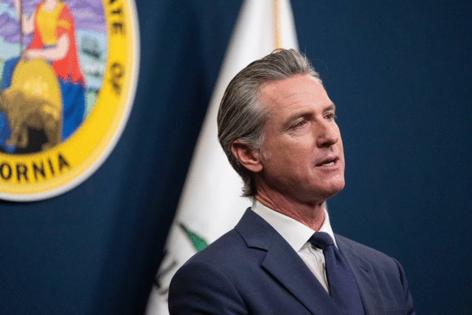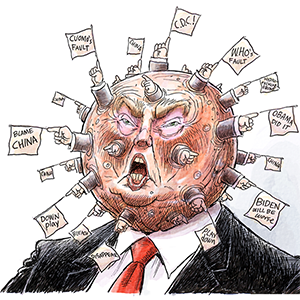California faces $18 billion deficit, fourth consecutive 'budget problem'
Published in News & Features
SACRAMENTO, Calif. — California’s state budget is in a precarious position heading into the next fiscal year — due in part to an AI boom — according to a forecast released Wednesday by the nonpartisan Legislative Analyst’s Office.
Lawmakers and Gov. Gavin Newsom face an $18 billion deficit to fill before the new fiscal year begins next July. That’s $5 billion higher than an estimate from earlier this summer. State leaders begin crafting a budget each January and are constitutionally required to have it passed and signed before the fiscal year begins July 1.
The larger deficit is due in part to H.R. 1, also known as President Trump’s “Big, Beautiful Bill,” which could cost the state $1.3 billion to backfill federal cuts to Medicaid and SNAP, which in California are called Medi-Cal and CalFresh. Those costs are expected to reach $5 billion by the 2029 fiscal year.
The deficit is the latest in a string of annual “budget problems,” as they are sometimes referred to in fiscal documents, to plague state lawmakers and Newsom, who have hesitated to impose significant expense cuts or broad tax increases in recent years.
Instead, Democrats in control of the state Capitol have largely opted to defer billions in spending to future years or borrow money from different funding sources, effectively kicking the can down the road. Last year, lawmakers also drew $7 billion from the state’s rainy day fund.
Now the budget position is “weak,” according to the LAO report.
“We face a somewhat sizable deficit problem in 2026-27 (fiscal year) and worse problems after that,” top Legislative Analyst Gabe Petek told reporters Wednesday. “This is happening in the context of an economy that’s not in recession, when the stock market has been going up and when revenues have been growing.”
There’s one bright spot in the state’s numbers: “Exuberance” around AI has led to higher-than-anticipated income and stock market taxes, but budget experts warn the growth is unsustainable.
“It now appears time to take seriously the notion that the stock market has become overheated,” the report notes. “History suggests that the stock market is prone to overreact to major technological advances, even if the technology itself turns out to be revolutionary.”
Petek emphasized that the LAO is not forecasting a downturn in California’s economy but a warning to policymakers that they should view the revenues linked to AI “as more of a temporary or unsustainable type of situation.”
The report also comes against a “lackluster” economic backdrop, Petek said, as borrowing costs remain high nationwide and consumer confidence is low because of stubbornly high prices. In California, job growth is stagnant, and sales tax revenue is flat as households have limited their spending — more warning signs for the state’s coffers.
California’s structural budget problem
As the state’s spending outpaces its revenue growth, Petek’s team has warned for years that California faces “structural” deficits in the tens of billions. The Wednesday report estimates annual deficits of around $35 billion beginning in 2027 “due to spending growth continuing to outstrip revenue growth.”
But Newsom and legislative leaders have largely ignored the LAO’s recommendations to fix the underlying imbalance. They’ve filled recent years’ budget holes through a mix of spending deferrals, internal borrowing and voter-approved bonds to fund climate projects and school infrastructure, along with billions taken out of reserve funds.
Petek acknowledged leaders’ reluctance to impose large-scale cuts in recent years despite deficits that have ranged from around $15 billion to as high as $55 billion in 2024.
“A lot of what state government does is providing services to vulnerable populations,” he said. Cutting those services is “not an easy choice to make.”
But the state budget is nearing a breaking point, according to his office’s report.
“One-time and temporary spending solutions are exhausted, and budget reserves are at about half of their peak,” it notes before adding: “California’s budget is undeniably less prepared for downturns.”
The report does not make specific recommendations for places lawmakers could cut or ways they could raise revenue. Petek said they did not intend “to get into that level of advice at this stage of the process.”
Top lawmakers in each chamber sought to blame the Trump administration for the state’s budget woes.
“Trump’s cuts and tariffs are squeezing California’s budget even harder,” Speaker Robert Rivas said in a statement. “We must invest limited dollars on sustainable, vital essentials — health care, food aid, housing, education. When Republican policies raise prices and fall short, Democrats will keep fighting for real affordability and lasting prosperity.”
“California’s economy remains steady, despite some self-inflicted economic wounds from our own federal government, including harmful tariffs, attacks on our workforce, and shortsighted federal budget actions,” said Monique Limón, who was recently sworn in as Senate President pro Tempore.
The top Republican on the legislative budget committee blamed California Democrats’ “unstoppable spending problems” for the lingering fiscal hole.
“The state must assess the effectiveness and sustainability of the programs that were created during the surplus and make necessary corrections,” Sen. Roger Niello, R-Fair Oaks, said in a statement.
Newsom’s office referred a request for comment to the Department of Finance. Spokesman H.D. Palmer said the LAO forecast “again highlighted the challenges that we’ve underscored throughout the year — federal uncertainty, market volatility, and continued growth in both cost and caseload for major state programs.”
“This year’s budget gap was closed through a range of solutions — including difficult but necessary actions to reduce ongoing expenditure growth and maintain budget resilience,” Palmer said in an email. “In the coming weeks, the Governor will be finalizing his decisions on how he’ll propose to meet these challenges in the coming year.”
Newsom is constitutionally required to present his spending proposal by Jan. 10.
_____
©2025 The Sacramento Bee. Visit sacbee.com. Distributed by Tribune Content Agency, LLC.







Comments